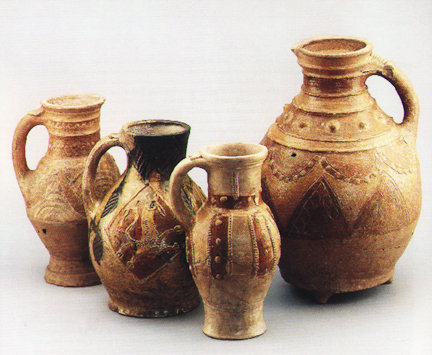
4 Medieval Pitchers, Earthenware with Slip Decoration, SE England, 1150-1300 CE
ART 198 - HISTORY OF WORLD CERAMICS
| After the Roman occupation of Britain, pottery continued to be made using the terra sigillata technique introduced by the Romans until the Medieval period(after the Norman conquest) when lead glazing and slip trailed pottery began to be produced. These 4 jugs, from SE England are typical of pottery of the period. During this period, potters had little social status and pottery was little more than utilitarian. Pottery was not widely used for eating, as wooden plates and bowls were preferred. Pots were used for serving, storing, or preparing foods, and large pitchers for ale, beer, milk and water were common household staples. Contemporary writers describe the process of glazing at that time as one of sprinkling powdered lead on the surface of the pottery. The use of applied ribbons and small balls of clay to the surfaces of vessels to create patterns and images was inspired by the style current in cities in France, such as Rouen. Some pitchers were made with tripod feet, as in the one on the far right, but more commonly, bottoms of pots were simply made, with a slight concavity. These pieces are wheel thrown from the local earthenware. The type of wheels used is not know with certainty, but they are thought to have been simple kick wheels made of a wheel head on which to throw, a central rod as an axis, and a lower flywheel to kick for momentum. Note the similarity in placement of the handles on these jugs. They are no larger than necessary, yet large enough for a hand. This minimizes breakage, and makes for effortless pouring. Bases on the pots are wide and stable as well. While the surface designs are not highly sophisticated, the shapes are strong and robust. | 4 Medieval Pitchers, Earthenware with Slip Decoration, SE England, 1150-1300 CE |
|
|